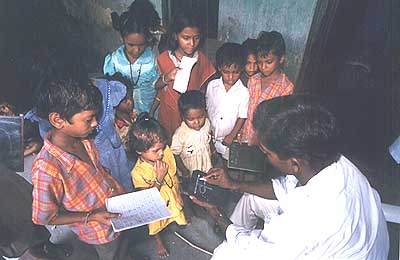(Bihar Times): While only 8 to 10 children attend
classes every day in T K Ghosh Academy, a government
school with 28 teachers, situated just in front of
Patna College in the heart of the state capital,
according to Pratham’s Annual Status of Education
Report (Rural) the number of out of school children in
the age group of six to 14 in the state has gone done
by half in just one year––from 24 lakh to 12 lakh.
Incidentally the Report, which was released by the
deputy chairman of the Planning Commission, Dr Montek
Singh Ahluwalia, in Delhi on January 16 also said that
the percentage of children from out of school has
fallen from 12.8 in 2006 to 6.5 2007. If the Report is
to be believed children of Bihar are now faring better
even in English and Arithmetic when compared with
their counterparts in several other states. In fact
they are better than the national average.

pix:Manish Sinha
There is no doubt that children from Bihar often fare
better in subjects like Arithmetic and even English.
What is strange is the manner in which the Report is
being twisted to claim that this ‘achievement’ was
possible just because of the steps initiated by the
human resources development department of Bihar in
just one year.
The principal secretary, human resources development
department, government of Bihar, Anjani Kumar Singh,
while talking to a section of Press went on to claim
that this was possible because of the appointment of
two lakh teachers and construction of 60,000 school
buildings. He also said that a large number of rural
students in Bihar are leaving the private schools to
join the government-run schools. But he ignored the
other aspects related to it.
On the other hand the truth is that only one lakh
teachers under centrally aided Sarva Shiksha Abhiyan
have so far been appointed and not two lakhs as the
state government is claiming. Even this appointments
have been made just seven to eight months back and
many of the teachers are yet to get adjusted to the
new job. Thus these new lots have least to contribute
to the success in this field.
Besides, the construction of 60,000 school buildings
have not been completed, thus, it would not be
appropriate to attribute the so-called success to this
factor too.
No doubt the number of school-going students have
gradually been rising, but other factors too are
involved in it. For example the central government’s
mid-day meal scheme in the rural areas have made much
bigger contribution than the appointment of teachers.
Even Pratham’s Report acknowledges that the number of
students in schools with mid-day meal being served had
gone up astronomically––from 38.4% in the year 2005 to
62.7% in 2007.
To ignore this aspect and just give credit to the
newly appointed teachers for this success would be a
gross injustice as most of these teachers do not go to
school even once a week. These newly appointed
teachers get something around Rs 5000 or so per
month––that is one-third of the permanent
teachers––and are even less efficient, talented and
prompt in their duty.
Besides, there is nothing much to celebrate such
achievements, which is more temporary in nature and
are for academic record. It needs to be mentioned that
a few years back Madhepura achieved cent per cent
literacy and Kishanganj won a national award in this
field. The fact is that people know what the ground
reality is in these two districts.
At the same time it needs to be understood that there
is scope of improvement only in states which lags
behind and not in those which are already ahead.
After all the Report said that states like Rajasthan,
Arunachal Pradesh, Manipur, Assam, Jammu and Kashmir,
Bihar, Uttar Pradesh and Madhya Pradesh are the
front-runners in showing improvement. They all are
least literate states.
In Rajasthan, for example, the figure of children out
of school came down from 10.8 per cent in 2006 to 6.5
percent by the end of 2007.
The unanswered question is: Why just 8 to 10 children
attend T K Ghosh Academy against the strength of
70-80? The possible answer is that there is no mid-day
meal scheme in this urban school, which has no primary
section. Besides, there is no girls here. Boys are not
entitled to get school dress free of cost.
This particular school has produced many great
personality, including a President (Dr Rajendra
Prasad). After all till mid-2007 the number of
teachers in this school was eight and now it is 28.
Though 20 more teachers joined the school seven months
back the number of students never increased––in fact
decreased.
More than the NGOs like Pratham it is the government
to adopt a more holistic approach rather than go by
just piecemeal measures and make tall claims.
*(The author is a Patna based free-lance journalist)